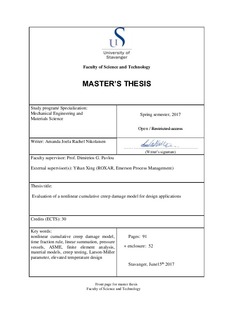| dc.contributor.advisor | Pavlou, Dimitrios | |
| dc.contributor.advisor | Xing, Yihan | |
| dc.contributor.author | Nikolaisen, Amanda Joela Rachel | |
| dc.date.accessioned | 2017-10-19T07:43:38Z | |
| dc.date.available | 2017-10-19T07:43:38Z | |
| dc.date.issued | 2017-06-15 | |
| dc.identifier.uri | http://hdl.handle.net/11250/2460946 | |
| dc.description | Master's thesis in Mechanical engineering | nb_NO |
| dc.description.abstract | Predicting creep damage and remaining life of an engineering design is a complex task. There are many types of creep material models and they provide significantly different predictions. Furthermore, the necessary material data required for the material models are rarely available. Creep tests are typically performed in uniaxial tension under constant load and temperature. However, such similar conditions are rarely encountered in practical engineering applications where multiaxial stresses and cyclic load and temperature often are present. Creep-fatigue interaction and correlation between uniaxial and multiaxial stress states also add on to the complexity of the damage assessment in creep conditions.
Pavlou have proposed a nonlinear cumulative creep damage model (NCCDM) that considers the sequence effect from the previous load history in the damage assessment. NCCDM has been evaluated for use in design applications and compared to a widely-used linear summation method known as the time fraction rule (TFR); TFR is used in several engineering design codes. Pavlou, Grell et. al, Lin and Teng have shown that NCCDM can predict creep damage more accurately than TFR under stepwise constant uniaxial stress and temperature conditions. However, NCCDM has not been used yet in practical engineering design applications.
In this thesis, NCCDM will be applied to a X8CrNiMoNb-16-16 pressure vessel designed in accordance with ASME VIII-2 to demonstrate its use in conjunction with practical engineering problems. The pressure vessel will be subjected to elevated temperatures with applied variable two-step loading. This is used as a representative engineering example for the comparison of the two models, i.e., NCCDM vs. TFR.
Firstly, by considering proposals made by Pavlou, Grell, Lin and Teng, an evaluation of the best use of the NCCDM was made. The model behaviour was also studied by considering fictive load cases. Based on the findings, conditions for further use of the model was established. Secondly, rupture and creep strength data obtained from a material database were used to create fitted curves with the Larson-Miller parameter from which time-to-rupture and time-to-1% strain could be obtained for different stresses. Thirdly, the finite element (FE) method was used to evaluate several types of stress criteria on a generic model of a pressure vessel. Variable-step internal pressure at a constant elevated temperature was applied to the model. A linear-elastic and an elastic-plastic material model was used in the analysis. By considering high-to-low (H-L) and a low-to-high (L-H) loading sequence the remaining life to rupture and to 1% strain was calculated for the pressure vessel with both NCCDM and TFR.
It was found that the NCCDM and the TFR gave very different predictions. For the L-H type of loading sequence the NCCDM predicted more conservative remaining life than TRF. The opposite was seen for the H-L type of loading. Larger variation in stress between the two load steps resulted in an increased difference between the predictions made with the two models. Due to the difficulty of performing a time-dependent creep analysis, the NCCDM model would benefit from being combined with an elastic-analysis procedure to approximate the time-dependent stress distribution, like the procedure in ASME-NH. Because of the simple use of NCCDM, there is potential for it to gain acceptance for engineering applications. However, further analysis and research should be made to fully understand the damage processes considered in the NCCDMs remaining life assessment. | nb_NO |
| dc.language.iso | eng | nb_NO |
| dc.publisher | University of Stavanger, Norway | nb_NO |
| dc.relation.ispartofseries | Masteroppgave/UIS-TN-IKM/2017; | |
| dc.rights | Attribution-NonCommercial-NoDerivatives 4.0 Internasjonal | * |
| dc.rights.uri | http://creativecommons.org/licenses/by-nc-nd/4.0/deed.no | * |
| dc.subject | materials science | nb_NO |
| dc.subject | materialer | nb_NO |
| dc.subject | konstruksjoner | nb_NO |
| dc.subject | nonlinear cumulative creep damage model | nb_NO |
| dc.subject | creep testing | nb_NO |
| dc.title | Evaluation of a nonlinear cumulative creep damage model for design applications | nb_NO |
| dc.type | Master thesis | nb_NO |
| dc.subject.nsi | VDP::Technology: 500::Mechanical engineering: 570 | nb_NO |

